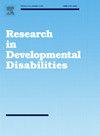Effectiveness of video displays versus traditional flashcards for global word learning in students with moderate-severe cognitive disabilities
IF 2.6
2区 医学
Q1 EDUCATION, SPECIAL
引用次数: 0
Abstract
Literacy is crucial for developing communication competence in students with complex communication needs (CCN). Existing technologies often inadequately support literacy strategies for these children. Augmentative and alternative communication (AAC) is a promising approach, and video visual scene display (VVSD) has emerged as a motivational feature for AAC intervention. This study examined the effectiveness of Smart-Glove, which combines VVSD and flashcards to teach global words to Hebrew-speaking students with moderate-severe intellectual disabilities (ID) and CCN. Using an adapted alternating-treatment design, the research compared Smart-Glove to the traditional global word approach. Four school-age students participated in 20 sessions over four months, each lasting 15–20 minutes and held 1–3 times weekly. The Smart Glove intervention established functional relationships with word identification performance for two of the four participants, while the traditional intervention demonstrated this relationship with one participant. For the participant who showed improvement with both interventions, gains emerged earlier during the Smart Glove condition. Smart-Glove was effective for the two younger students (mean age 9:9) with moderate ID, but not for the two older students (mean age 18:5) with severe ID. These findings highlight the importance of age and cognitive level in personalizing literacy instruction. The study also suggests gradual implementation of these programs in increasing word exposure and intervention duration. Smart-Glove's integration of VVSD with the traditional approach potentially enhances literacy acquisition for children with moderate ID and CCN, offering new possibilities for personalized literacy instruction in special education settings.
视频显示与传统抽认卡对中重度认知障碍学生全球词汇学习的效果
在有复杂交际需求的学生中,读写能力是培养交际能力的关键。现有技术往往不能充分支持这些儿童的扫盲战略。辅助和替代交流(AAC)是一种很有前途的方法,视频视觉场景显示(VVSD)已成为辅助和替代交流干预的动机特征。这项研究考察了Smart-Glove的有效性,它将VVSD和抽认卡结合起来,向有中重度智力残疾和CCN的讲希伯来语的学生教授全球词汇。该研究采用了一种适应的交替处理设计,将Smart-Glove与传统的全球词方法进行了比较。4名学龄学生参加了为期4个月的20次课程,每次15-20 分钟,每周1-3次。智能手套干预与四名参与者中的两名参与者的单词识别表现建立了功能关系,而传统干预只与一名参与者建立了这种关系。对于两种干预措施都有所改善的参与者,在智能手套条件下,收益出现得更早。Smart-Glove对中度ID的两名低年级学生(平均年龄9:9)有效,但对重度ID的两名高年级学生(平均年龄18:5)无效。这些发现强调了年龄和认知水平在个性化识字教学中的重要性。该研究还建议逐步实施这些计划,以增加单词接触和干预时间。Smart-Glove将VVSD与传统方法相结合,有可能提高中度ID和CCN儿童的识字能力,为特殊教育环境下的个性化识字教学提供新的可能性。
本文章由计算机程序翻译,如有差异,请以英文原文为准。
求助全文
约1分钟内获得全文
求助全文
来源期刊

Research in Developmental Disabilities
Multiple-
CiteScore
5.50
自引率
6.50%
发文量
178
期刊介绍:
Research In Developmental Disabilities is aimed at publishing original research of an interdisciplinary nature that has a direct bearing on the remediation of problems associated with developmental disabilities. Manuscripts will be solicited throughout the world. Articles will be primarily empirical studies, although an occasional position paper or review will be accepted. The aim of the journal will be to publish articles on all aspects of research with the developmentally disabled, with any methodologically sound approach being acceptable.
 求助内容:
求助内容: 应助结果提醒方式:
应助结果提醒方式:


